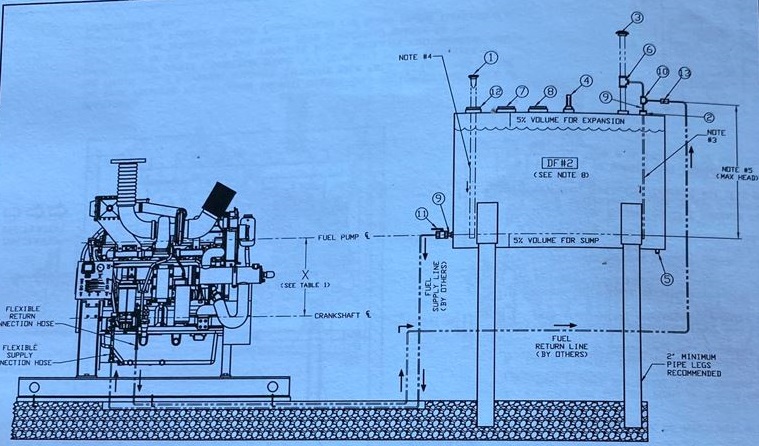

Traditionally NFPA 20 required that diesel fuel tanks be sized for 1 gallon per engine horsepower plus 5% for sump and 5% for expansion. This requirement is intended to allow for 12 hours of total run time with 8 hours of run time being available when the low fuel alarm is triggered at the 2/3 level. Diesel engines have become more fuel efficient over time resulting in increased actual run times.
In the 2022 edition of NFPA 20, the method for sizing a diesel fuel tank was revised to consider the fuel efficiency of modern diesel engines. The fuel tank is to be sized for 12 hours of run time at the engine’s fuel consumption rate plus 5% for sump and 5% for expansion (NFPA 20 §11.4.1.3.1). This may result in a savings on the initial cost to fill the tank. When NFPA 20 was updated, HGI considered a move to the new fuel tank sizing method. We determined that we are in no big hurry to reduce the size of the fuel tank, but we will revisit it as the 2022 edition becomes more widely enforced.
In mid-August 2023, we had the pleasure to visit Underwood Fire Equipment’s shop near Detroit and we met with Mr. Damon Pietraz (President). After the nickel tour of their impressive facility, Damon pointedly asked, “When are you going to let us start using the smaller fuel tanks?” We told him we have no current plans to adopt the smaller fuel tanks. Now, when the sprinkler contractor positions the fuel tank too low (vertically), they have an opportunity to perform a calculation to prove that the fuel level above the fuel pump centerline supports a 12-hour duration rather than raise the fuel tank. A fuel tank that we reviewed the previous week was 1.5 inches too low. We feel that the built-in “safety margin” is worth the one-time cost of the additional fuel. Based on our experience, nearly one in five diesel fuel tanks are initially installed too low*.
According to Damon, “The potential cost savings is more drastically skewed towards the larger HP engines. Engines greater than 350 hp may realize a fuel tank size that is 30% smaller than tanks sized prior to 2022 edition of NFPA 20. By the time the cost of delivered fuel is factored in, the end user could see a $4-5,000 savings for each installation. However, for an engine selection in the 150-175 hp range, the updated fuel tank sizing guideline would offer only a 15% reduction in tank size and may result in a $300-400 cost saving in tank cost and initial fueling expense.”
*The fuel supply outlet of the diesel fuel tank is required to be located at or above the centerline of the diesel engine’s fuel pump. Where is the fuel pump? Verify with the engine manufacturer. Thanks to Clarke Fire Protection Products for providing this pump drawing from their Installation and Operations Manual that clearly defines the fuel pump centerline location relative to the engine’s crankshaft centerline.

